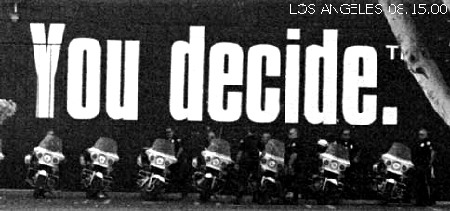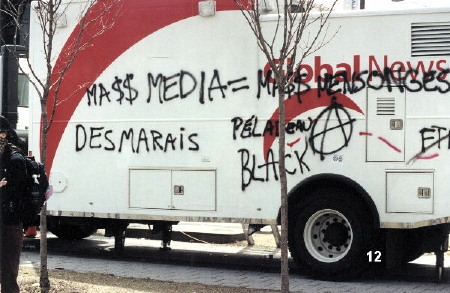
Los Angeles, 08.15.2000.
When searching for indications of the global multitude, it has become something of a commonplace for theorists such as Negri, Marazzi, Virno and other Italian Autonomists (but not limited to them) to point towards the “antiglobalization movement,” which is usually granted its worldwide stage debut at the WTO protests in Seattle (1999) with further economic summit gatherings making their mark as well as traditional political gatherings (DNC in LA, 2000; World Economic Forum in Davos, 2001; FTAA in Genoa, 2001; Summit of the Americas in Québec City, 2001). With 9/11, the “movement” is usually seen as dissipating into an antiwar focus; moreover the possibility of organised mass protest after 9/11 disintegrates in the wake of repressive “security” measures globally. The question is how this time of global, networked turbulent uprising has been represented & interpreted among theorists.
Commenting on Naomi Klein’s No Logo, Christian Marazzi writes (circa 2002) that:
The “no logo people” has been constituting itself with protest tactics against the privatization of public space, against the symbolic commodification effected by the multinational producers of consumer goods. The protests against the logo and against the world circuit of exploitation of the work force described by Klein have worked as a lever in the global growth of an “antiglobal” movement. (Capital and Language 138)
Marazzi’s summation remains limited in two respects. First, it is somewhat of a one-dimensional analysis insofar as it accepts without question the term “antiglobal” while overplaying the significance of the “no logo people.” Second, Klein’s No Logo, significant now as it was then in providing the framework for an analysis of the symbolic structures of global capital, remains theoretically and descriptively inadequate to encompass the diverse manifestations of what is not an antiglobalization movement, but an alterglobalization convergence. There remains a terribly incomplete perception of the alterglobalization convergence of the mid-’90s to 2001 among theories of the multitude (Marazzi goes on to write: “The global crisis of the logo, in other words, suggests that it is on the terrain of the political definition of the body of the multitude that the future of the protest movement will be played out”).
The perception of the alterglobalization convergence as an antiglobalization movement continues to the point where Marazzi, agreeing with an analysis provided by The Economist (8 September 2001), sees its global network of antiglobal protest as something of an irony, if not a paradox that discredits the movement’s aims:
The logo is power, of the consumer and the producer, a power based on trust, fidelity, the loyalty of the consumer that capitalist businesses must conquer by working hard on the linguistic-communicative level. The power of the logo has literally constituted the space of the global economy, bringing manufactured commodities to unknown lands and so making them known to the wage laborers of the most developed economies. That is why, writes The Economist, with more than a little irony, the protest against the logo has allowed the antiglobalization protest movement to become known all over the world. As though to say that the power of the logo consists in establishing a symmetrical – or worse dialectical – relationship between logo and no logo, between the power of capital and “globalization from below,” between the use value of commodities and the living body of the movement (a problem about which Klein is politically aware and which looms in the background throughout the 500 pages of No Logo). (139)
Granted, we are in 2001, three days before 9/11. But this is beside the point: why has Marazzi accepted not only Klein’s narrative of the “antiglobalization movement” as “no logo people,” but The Economist’s? It is as if (often Autonomist) theorists of the day failed to realise that the primary channel of communication of the alterglobalization convergence at the time was IndyMedia, not CNN (nor BBC, etc.). The medium of communication was integral to the message; which also says much concerning a theoretical inadequacy that remained blind to the multidimensionality of the convergence’s actions, not the least of which was founding decentralized independent media platforms (which later became the basis – rebranded and hyped – of Web 2.0 / social media).

FTAA @ Québec City, 2001.
For theories of the multitude to be successful they must adequately describe the richness of the convergence. Unfortunately Marazzi fails to source more reliable information on the alterglobalization movement, and he reduces it three times, whittling it down until its multidimensionality becomes unidimensional, flat, and eventually dialectical (the multidimensionality of which should be emphasized if one is to argue the movement’s embodiment qua multitude as a convergence). The lack of depth information on the convergence means that the alterglobalization convergence, with its multiple convergences of interests, approaches, and groups – as was seen in the “pie style” protests of Seattle, which included all groups as flying wedges, a convergence – becomes reduced to the oppositional political ontology of being merely antiglobalization, as if the entire point of this movement was to resist globalization, the globe itself. This myth was branded at the onstart of Seattle’s corporate media coverage, successfully I might add, by the major news networks. This convergence rarely if ever called itself “antiglobal” at this point, and was only named as-such in media (which had the secondary effect of attracting new, reactionary adherents by way of this reductive branding). In fact, those that converged in Seattle – or better, APEC ’97 in Vancouver some two years prior – focused on the complexity of global issues surrounding the extortion of underdeveloped workforces, the pollution of underdeveloped countries, and the strong-arm tactics of unelected, unaccountable neoliberal organisations such as the WTO, all to the favour of developed countries in maintaining their privilege and hegemony over world trade, politics and ultimately power.
Second, the alter-convergence also raised the point that many of these trade bodies were doing deals with the devil (such as APEC’s dealings with Suharto in Indonesia), thereby supporting dictators brutalizing segments of their population in exchange for resources and trade. In short, justice was demonstrated to be secondary to economic trade, profit, gain, etc.. Third, this critique proposed alternative models, all of which focused on the need for democratic, elected and equal representation of the citizens of each country in the brokerage of trade, and for the unalienable, unalterable positioning of human rights and the environment in all worldwide, global negotiations. Due to the irrecoverably neoliberal stance of institutions of the WTO, FTAA, APEC, WEF, IMF and World Bank (what was called “alphabet capitalism”), the critique was negative: these institutions need be destroyed, and new convergences built. Part of this meant seeking to shift the developed world’s hunger from exploiting cheap products, labour and resources from underdeveloped countries to local production; but only under broader calls for fair trade and fair unpolluted living for all.
Marazzi’s second reduction consists of reducing antiglobalization to merely a “no logo” movement by way of Klein. The countersymbolic aspects of the alterglobalization convergence are precisely that – countersymbolic warfare – insofar as anti-State and anti-corporate street warfare is drastically counterproductive (as Bey pointed out with his seminal text on the TAZ). If one can’t destroy the multinational cartels exploiting underdeveloped nations – like cell-based terrorism, there is no centralized “front” to attack – one destroys their brand, one attacks their control over consumer markets, one attacks their local workplaces, one attacks, in short, the breeding ground of their very existence. To say this has to do with a resistance to “global branding” misses the point entirely.

APEC 1997, Vancouver.
The third reduction consists in reducing the “no logo people” (as this alterglobalization convergence has now been whittled down) to “the protest against the logo,” thus allowing The Economist to deploy some minor Hegelian dialectics in pointing out that merely opposing the logo reinforces the logo as an object to be opposed. That this haunts Klein (which I am not so sure) only demonstrates the one-dimensional aspect of both Marazzi and Klein’s important but flawed – for these very reasons – analyses. When No Logo came out it was critiqued on these grounds; it reduced the complex demands of the alterglobalization convergence to that of a “symbolic” struggle, a struggle against symbols. It mistook the tactical means of culture jamming as its strategic goals, which isn’t quite to say Klein mistook the means for the ends (as certainly the tactic is part of the strategy, and vice-versa), but rather that Klein, perhaps unwittingly through the success of her text, overemphasized countersymbolic warfare in an attempt to provide an exegesis of the alterglobalization convergence to the apparently bewildered (Euro-left theorists unfortunately included).
So when Marazzi writes,
The limits of the antiglobal movement are, therefore, political, in the sense that, in trying to expand on the terrain of the symbolic politics of power, it has come up against the limits of its analysis of the workings of global capitalism. (139)
–– he has only come up against his own limits – historical, political, epistemological, ontological, onticological – in regards to the alterglobalization convergence. While it is correct that the alterglobalization convergence included both culture jammers lacking philosophic analyses of global capital, trade unionists without savvy of countersymbolic warfare, and old vanguardist types of the Left Leader Name Brand variety hopelessly clutching Leninist flags, none of this means that complex analyses of global capital did not exist, nor that the ultimately successful swarming of this multitude wasn’t a cornucopia of critique against capital, and a wealth of alternative proposals. Nor, in hindsight, can the convergence be reduced to any such unidimensional statement.
Marazzi goes on to write that the movement risks becoming a “protest movement” (true; but only risked doing so in the continued and ultimately successful branding of the movement as such by corporate media, insofar as corporate media refused to report on the alternative solutions proposed, thus raising the height of spectacular protest in a zero-sum game of attention economics – as the video above analyses); that it risks becoming a “minority” at the height of its popularity (9/11 conveniently intervened before this critique could be played out); and that its “leaders” (what leaders? Klein?) risked becoming “caught up in a decidedly vacuous logic of negotiation” (again, what leaders? what negotiations? does Marazzi mean the attempts by NGOs to overtake various economic forums in the name of the “no logo people”?).
The alternative history of the alterglobalization convergence has yet to be theorized within Autonomia, and that includes Hardt and Negri’s Empire, Multitude and later projects. Moreover, this movement has changed, even from taking on the necessary task of becoming an antiwar convergence to a much more complex series of actions taking place at multiple levels, incorporating permaculture, ecosustainable practice and the jumpstarting of countless small fair-trade initiatives. This is the wealth of the alterglobalization “protest movement” which has since got down to the business of effecting the change one wants to see irrespective of the confines in which one is supposed to live.
Tags: Marazzi, Negri, protest, TAZ
.tinyUrl for this post: | https://tinyurl.com/y9kv3x4u .




 RT
RT 